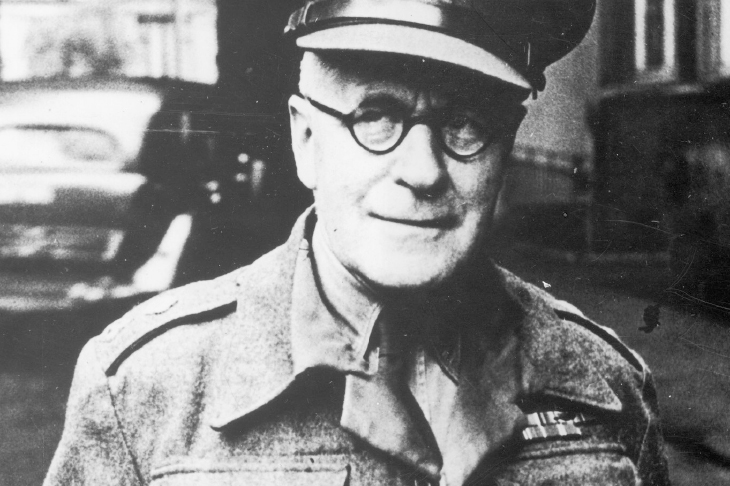Hidden behind Kensington Palace, in one of London’s smartest streets, there is a grand old house which played a leading role in Britain’s victory over Nazi Germany. Today it’s owned by Roman Abramovich, apparently — it seems he paid £90 million for it. But during the second world war, and for a few years thereafter, 8 Kensington Palace Gardens was a secret interrogation centre known as the London Cage. This is where suspected spies (and, later, suspected war criminals) were broken down. Between 1940 and 1948, thousands of German servicemen passed through here, on their way to POW camps (if they were deemed innocent) or prison (if they were guilty). The information that was squeezed out of them in this secluded mansion saved the lives of countless Britons, and avenged the deaths of many more.
The interrogators all spoke fluent German, but that was just about all they had in common. There were lawyers and academics, journalists and businessmen (there were no women here). A few were refugees from Nazi Germany, but most of them were British. These Brits were an odd bunch, and the oddest of the lot was their boss, Colonel Alexander Scotland.
Alexander Scotland is the flawed hero of this grim but gripping saga. As a young man he’d sailed to southern Africa to seek his fortune and ended up serving in the Kaiser’s army before the first world war. During the Great War he was imprisoned by the Germans, for a while in solitary confinement. They suspected him (with good cause) of being a secret agent.
After the war he went to Argentina — ostensibly as a businessman, but probably also as a spy. Through his German contacts, he enabled several hundred German Jewish families to flee to South America, rescuing them from the impending Holocaust. He made several visits to Germany, and had a brief meeting with Hitler. ‘You are an ingenious man, Schottland,’ said the Führer. ‘Now I understand the reports we have on our files about you.’ His unique knowledge of German espionage, the German military and German interrogation methods made him an invaluable commander of the London Cage.
In 1954 Scotland wrote his memoirs, but Special Branch raided his publishers and seized the manuscript. They told him he couldn’t publish. He told them he’d publish in the United States. Eventually, in 1957, he was allowed to publish a heavily censored version, which spawned a fanciful film called The Two Headed Spy, starring Jack Hawkins as a special agent called ‘Alex Schottland’. Now, finally, the original manuscript has been released by the National Archives. This uncensored version is the backbone of Fry’s absorbing book, and Scotland’s powerful personality dominates virtually every page.
‘Interrogation is an art,’ said Scotland, and he proved himself a master of this dark art form, finding a different way to wear down each suspect. Sometimes he adopted the softly-softly approach. Often, he could be brutal. ‘Not only is it the firm rule of the British Services that no physical force may be used to induce a prisoner to talk, but I have always considered it to be useless as well as unnecessary,’ he declared. This was not always the case. Prisoners were rarely beaten, but they were deprived of sleep for days on end, threatened with execution and forced to perform exhausting and humiliating tasks (marching for hours until they collapsed, scrubbing their cells with toothbrushes) which echoed the pettier punishments of the Gestapo.
Were Scotland’s men really as bad as the Gestapo? Of course not; but some of their methods were uncomfortably similar (truth drugs and electric shocks; forcing inmates to stand naked for eight hours or huddle in cold baths for four). Some inmates were SS men who’d slaughtered British POWs and Jewish civilians, but others were simply regular soldiers who refused to reveal any more than their name, rank and serial number. Some of them were hospitalised. Several committed suicide. Was this torture? Maybe not; but it was certainly a clear breach of the Geneva Convention. ‘We cannot have this sort of thing going on,’ wrote Guy Liddell, director of counter-espionage at MI5, in his diary. ‘Apart from the moral aspect, I am quite convinced that these Gestapo methods do not pay in the long run.’ Ironically, it was often more productive to leave the prisoners to their own devices, put a few of them in a cell together and simply eavesdrop on what they told each other.
Whatever the rights and wrongs, the London Cage played a crucial role in the war effort; but some of its most valuable work came after VE Day. From 1945 to 1948, Scotland’s men tracked down and interrogated many of Germany’s most brutal war criminals. Despite seeing the worst of Deutschland, however, Colonel Scotland was no Teutonophobe. He befriended Field Marshal Kesselring, whom he interrogated in the London Cage, and became convinced of his good character. When Kesselring was sentenced to death for war crimes (German soldiers under his command had killed hundreds of Italian civilians), Scotland even wrote a book in his defence. Kesselring’s sentence was commuted, and he was eventually released. Scotland was awarded the OBE and died in 1965, aged 82. In 1958, after the publication of his censored memoir, he asked the Home Office to return his confiscated manuscript. They refused.






Comments